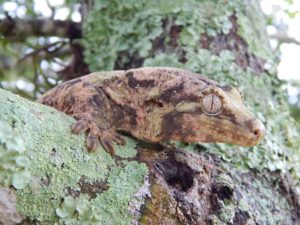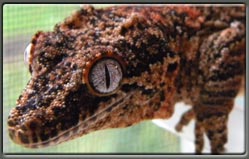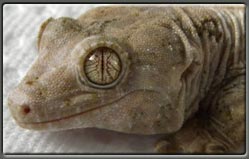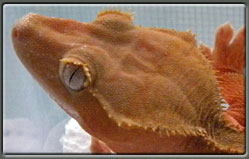
 Mniarogekko chahoua is also known as the ‘Mossy prehensile tailed gecko’. It gets its common name from having the most prehensile tail of all the New Caledonian species and the moss- or lichen-like pattern it displays. Chahoua are found natively in forested areas on the southern and central portions of the island of Grande Terre and on the outlying island of Isle de Pines. Chahoua is the third largest, commonly reaching a snout to vent length (SVL) of 5.5 – 5.7 inches. The Pine Island locals tend to be larger and may reach 12 inches in total lentgh. Chahoua are heavy-bodied and arboreal, spending most of their time off the ground in the lower shrubbery and are not usually found in the upper canopy. They are nocturnal, emerging at night to feed and mate. Chahoua can become quite tame as a captive. This species is favored by gecko hobbyists because of its extremely composed and calm nature when handled.
Mniarogekko chahoua is also known as the ‘Mossy prehensile tailed gecko’. It gets its common name from having the most prehensile tail of all the New Caledonian species and the moss- or lichen-like pattern it displays. Chahoua are found natively in forested areas on the southern and central portions of the island of Grande Terre and on the outlying island of Isle de Pines. Chahoua is the third largest, commonly reaching a snout to vent length (SVL) of 5.5 – 5.7 inches. The Pine Island locals tend to be larger and may reach 12 inches in total lentgh. Chahoua are heavy-bodied and arboreal, spending most of their time off the ground in the lower shrubbery and are not usually found in the upper canopy. They are nocturnal, emerging at night to feed and mate. Chahoua can become quite tame as a captive. This species is favored by gecko hobbyists because of its extremely composed and calm nature when handled.
Colors range from rusty red and brown to green or gray with varying amounts of white flecks and/or white patches over the neck and pelvis. As with other New Caledonian geckos, chahoua are log lived, with captive animals over twenty years old. Currently there are two recognized locales, Pine Isle and the Grande Terre or Mainland.
Minimum enclosure size for a single animal should be around 30 gallons (18″ x 18″ x 24″; 18″ x 18″ x 36″ for a pair). Chahoua usually take 18 – 24 months to become sexually mature. Males develop large external hemipenal bulges and pre-anal pores. Breeding starts as early as March and extends as late as November. They will typically lay a clutch of two eggs every 60 days, providing 3 – 4 clutches per breeding season. Females can be very susceptible to calcium deficiency and metabolic bone disease after the 2nd or 3rd clutch. This is because their eggs are highly calcified, and require a large amount of calcium. Be sure to carefully monitor for early signs of calcium deficiency. Common first symptoms are snowflaking in the eggs or zigzagging of the tail. As long as the female is given sufficient calcium, she will quickly recover.
Click below for species-specific information
 |
 |
 |
|---|---|---|
| Gargoyle Gecko | Chahoua | Crested Gecko |